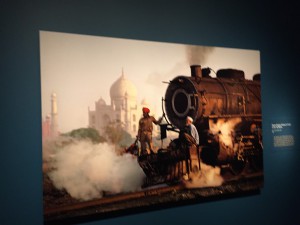The Steve McCurry Exhibit in the Rubin Museum was really great. I loved the environment because it seemed simple and high class. The entrance felt warm and calm. It was interesting to see a restaurant section on the first floor. The stairs in the middle of the exhibits was also very interesting, it allowed for easy access to all the exhibits the museum offered. The Steve McCurry exhibit felt dark and calm. With the blue walls, and lights on the photographs, it made the photographs pop out more and gain more emphases to them.
The Steve McCurry Exhibit included a range of different photos that he took in India, around the 1980’s -2000’s. He caught many rare moments of Indians living their lives. His photographs beautifully display the theme of truth and humanity. In his photos, McCurry has a nice mix of subjects like Architecture,Transportation ,animals , and humans. In this exhibition you can find a map showing the location of each photo.
My favorite photograph at the, McCurry Exhibitions, was “Steam Engine of Taj Mahal”. I love the composition, field of depth, and atmospheric perspective. The steam created by the old train adds a interesting element, while also becoming a frame for the background. The two humans on the train bring out a sense of humanity, from a scene that is primarily covered by architecture and design.
Steve McCurry most famous photo is the, “Afghan Girl”. Its a striking photo of a young beautiful girl. She seems to be scared or in shock, but her green eyes and complementary colors of red and green makes this image a strange mix of serious but beautiful. I learned a lot from this museum, it has inspired me to maybe go to different places around the world and take pictures. It even showed me that a picture printed at a large scale, and placed in the right environment can make a photograph come to life. After seeing the exhibition I realized that a photograph can be as effective and powerful ( when printed at a large scale) as a piece of art is.





Your last comment is interesting. A century ago, there was an ongoing debate: could photography, something made by a machine, be art. The debate is largely settled in photography’s favor. Many photographers still feel that they have to compete with painting and other fine arts that have a high value in our society. One of the ways is by making the photos bigger. Certainly, it does amplify the experience of seeing the photo when it surrounds you as opposed to being a small square in the rectangle of a phone.